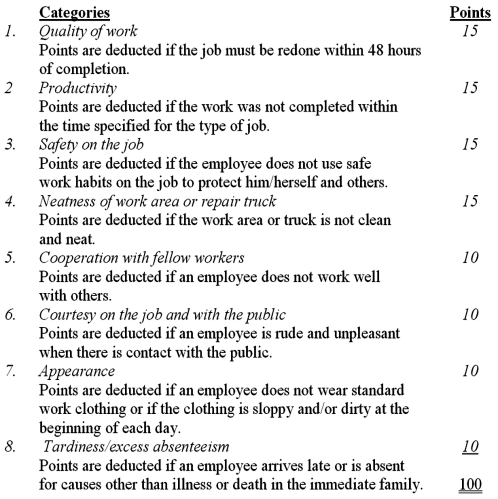Harold Small joined Morton Electric Company eight months ago as Vice President of Personnel Administration. Morton Electric Company is a small regional public utility serving 50,000 customers in three communities and the surrounding rural area. Electricity is generated at a central plant, but each community has a substation and its own work crew. The total labor force at the central plant and three substations, exclusive of administrative and clerical personnel, numbers 180 people.
Small designed and introduced a Performance Evaluation and Review System (PERS) shortly after joining Morton. This system was based upon a similar system he had developed and administered in his prior position with a small company. He thought the system had worked well and that it could be easily adapted for use at Morton. The purpose of PERS, as conceived by Small, is to provide a positive feedback system for evaluating employees that would be uniform for each class of employees. Thus, the system would indicate to employees how they were performing on the job and help them correct any shortcomings. The Plant Supervisors and Field Supervisors are responsible for administering the system for the plant workers and the substation crew workers respectively. The General Supervisors are responsible for the Plant/Field Supervisors. Employees get personal PERS Reports monthly informing them of their current status, and there is a review and evaluation every six months.
PERS is based on a point system in an attempt to make it uniform for all workers. There are eight categories for evaluation with a maximum number of points for each category and a total of 100 points for the system. The eight categories for the plant and crew workers and the maximum number of points in each category are as follows.
 The list of categories used to evaluate the Plant/Field Supervisors is slightly different.
The list of categories used to evaluate the Plant/Field Supervisors is slightly different.
Each employee begins the year with 100 points. If an infraction in any of the categories is observed, one to five penalty points can be assessed for each infraction. Notification is given to the employee indicating the infraction and the points to be deducted. A worker who is assessed 25 points in any one month or loses all the points in any category in one month is subject to immediate review. Likewise, anytime an employee drops below 40 points, a review is scheduled. The General Supervisor meets with the individual employee and the employee's Plant/Field Supervisor at this review.
If an employee has no infractions during the month, up to 12 points can be restored to the employee's point total - two points each for Categories 1-4 and one point each for Categories 5-8. However, at no time can a worker have more than the maximum allowed in each category or more than 100 points in total.
When Small first introduced PERS to the General Supervisors, they were not sure they liked the system. Small told them how well it had worked where he had used it before. Small's enthusiasm for the system and his likeable personality convinced the General Supervisors that the system had merit.
There were a few isolated problems with the system in the first two months. However, Ray Meyers, a crew worker, is very unhappy with the new system as evidenced by his conversation with Dan Jenkins, a fellow crew worker.
Meyers: "Look at this notice of infraction - I have lost 22 points! I can't believe it!"
Jenkins: "How did your supervisor get you for that many points in such a short period?"
Required:
(1) What are the strengths and weaknesses of the Performance Evaluation and Review system (PERS) in terms of the design for a review and evaluation system and for the expected motivational effects?
(2) What problems might occur in the administration of the PERS system?
Definitions:
Forest Communities
Ecosystems composed of trees and other plant species, along with associated animals, microorganisms, and the physical environment, interacting as a unit.
Succession
The process by which ecosystems change and develop over time, often following a disturbance.
Climate
Average weather conditions, plus extremes (records), that occur in a given place over a period of years.
Species Richness
The number of different species represented in an ecological community, landscape or region.
Q47: A manager who is organized and self-disciplined
Q57: The need for affiliation is the extent
Q68: The tool that can be used to
Q98: Fayol's principle of initiative suggests that:<br>A) employees
Q104: _ values help explain what managers are
Q106: Using revenue as an allocation base, the
Q108: Which of the following is not a
Q125: Which of the following items represents a
Q131: This question pertains to the use of
Q135: If the minimum rate of return is